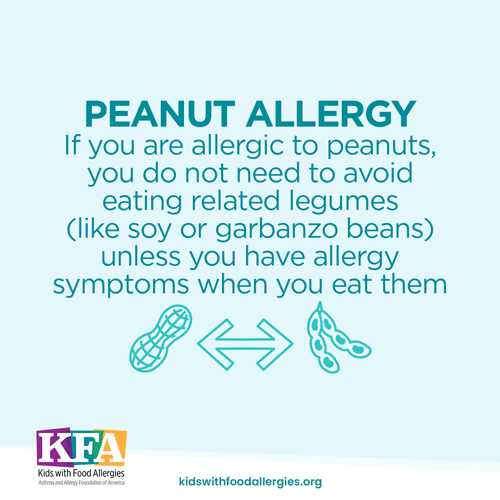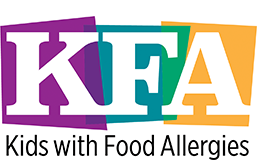Living with Food Allergies

Food Allergies and Cross-Reactivity
A food allergy occurs when the immune system overreacts to a food.
The most common type is when the immune system makes a type of antibody called IgE to proteins in a particular food. This is an IgE-mediated food allergy. When exposure to the food occurs, symptoms start quickly. Symptoms include any or several of the following: skin itching, hives, swelling of the skin, nausea, vomiting, diarrhea, breathing difficulty (wheezing, repeated throat clearing, cough, throat tightness), or anaphylaxis. Anaphylaxis is a severe allergic reaction that is rapid in onset and progressive. Symptoms of anaphylaxis involve more than one organ system from the above list. They can also include dizziness or loss of consciousness (from a drop in blood pressure) and other serious, potentially life-threatening complications. Anaphylaxis can occur with any IgE-mediated food allergy.
The most common food allergens are milk, egg, wheat, soy, peanut, tree nuts, fish and shellfish.
Cross-reactivity occurs when the proteins in one substance are like the proteins in another. As a result, the immune system sees them as the same. In the case of food allergies, cross-reactivity can occur between one food and another. Cross-reactivity can also happen between pollen and foods or latex and foods.
Because of cross-reactivity, testing and diagnosis of food allergies can be challenging. Since the immune system sees the similar proteins as the same, a positive skin test or blood test (serum IgE) can result for a food, yet the patient may be actually allergic to a substance that is cross-reactive to that food. However, the individual may or may not have any allergic symptoms from eating that food. The individual may not have allergic symptoms from a food that is cross-reactive with another food or pollen to which the individual is allergic. This is true even though they have a positive skin test or blood test to that food. This point cannot be emphasized enough. Many people end up avoiding foods because of a positive test and in some cases, they may have been eating that food before without any problems.
Cross-Reactivity Between Cow’s Milk and Milk from Other Mammals
There is a high degree of cross-reactivity between cow’s milk and the milk from other mammals such as goat and sheep. In studies, the risk of allergy (resulting in symptoms) to goat’s milk or sheep’s milk in a person with cow’s milk allergy is about 90%.
The risk is much lower, about 5%, for allergy to mare’s milk (or donkey’s milk) which is less cross-reactive with cow’s milk.
Cross-Reactivity Between Foods in the Same Animal Group
Cross-reactivity is uncommon between foods in the same animal group. For example, most people with an allergy to cow’s milk can eat beef and most people with an allergy to egg can eat chicken without any symptoms to the respective meats.
Cross-Reactivity Between Peanut and Other Legumes (Soy and Beans)
Peanuts and soybean are in the legume family, which includes beans and lentils. A common question that comes up for people with an allergy to peanut is whether they can eat soy-based foods or other beans. More than 50% of peanut-allergic individuals will have a positive skin test or blood allergy test to another legume (soy, other beans) but it turns out that 95% of them can tolerate and eat the cross-reactive legumes. Many years ago, it was common to recommend avoidance of legumes, including soy, because of a peanut allergy but this practice has been proven unnecessary.
Cross-Reactivity Between Peanut and Tree Nuts or Seeds
 As noted above, peanuts are legumes and are not related to tree nuts (almonds, walnuts, cashews, etc.). However, about 35% of peanut-allergic toddlers in the U.S. have or will develop a tree nut allergy. It is fairly common to be “co-allergic” to tree nuts if a child is peanut allergic. Doctors thus recommend that young children avoid tree nuts if they are peanut-allergic. Safety is also a concern. Young children may have a hard time distinguishing a tree nut from a peanut. Thus, there is the potential of cross-contamination of tree nut products with peanut. Studies have investigated whether the common occurrence of allergy to both peanut and tree nuts is due to allergen cross-reactivity. At least one study revealed that there MAY be some cross-reactive parts of the allergic proteins in common. But true cross-reactivity is unknown. However, the larger issue is that allergy to tree nuts is common in peanut allergic individuals. Doctors should watch for tree nut allergy in peanut-allergic individuals. Their recommendations should be made on an individual basis.
As noted above, peanuts are legumes and are not related to tree nuts (almonds, walnuts, cashews, etc.). However, about 35% of peanut-allergic toddlers in the U.S. have or will develop a tree nut allergy. It is fairly common to be “co-allergic” to tree nuts if a child is peanut allergic. Doctors thus recommend that young children avoid tree nuts if they are peanut-allergic. Safety is also a concern. Young children may have a hard time distinguishing a tree nut from a peanut. Thus, there is the potential of cross-contamination of tree nut products with peanut. Studies have investigated whether the common occurrence of allergy to both peanut and tree nuts is due to allergen cross-reactivity. At least one study revealed that there MAY be some cross-reactive parts of the allergic proteins in common. But true cross-reactivity is unknown. However, the larger issue is that allergy to tree nuts is common in peanut allergic individuals. Doctors should watch for tree nut allergy in peanut-allergic individuals. Their recommendations should be made on an individual basis.
The same hold for peanut allergy and allergy to seeds such as sesame seed. There are a few individuals who are allergic to both. This is likely due to the occurrence of more than one food allergy in highly allergic individuals rather than cross-reactivity. With respect to tree nuts, there is high degree of cross-reactivity between cashew and pistachio and between walnut and pecan. Most people who are allergic to one tree nut are not allergic to all tree nuts.
Cross-Reactivity Between Fish
There is a lot of cross-reactivity among different species of fish including fresh and salt water fish. The risk of allergy to other fish when an individual is allergic to one fish is about 50%.
Cross-Reactivity Between Shellfish
Shellfish, like fish, peanuts, and tree nuts are commonly associated with severe, potentially life-threatening reactions. There is a high degree of cross-reactivity among the crustacean shellfish (shrimp, lobster, crab, crawfish). The risk of allergy to another crustacean shellfish is 75%. The risk may be lower for cross-reactivity between crustacean shellfish and non-crustacean shellfish (mollusks) such as clam, oyster, scallop, mussels. Of note, there is cross-reactivity between chitins (a component of exoskeleton of shellfish and insects) in dust mites and crustacean shellfish. This can result in “false positive” testing for shellfish without any clinical symptoms.
Cross-Reactivity Between Pollen and Foods (Pollen-Food Syndrome or Oral Allergy Syndrome)
Some individuals with pollen allergies (allergic rhinitis or hay fever) can develop symptoms around and in the mouth and throat immediately after eating raw fresh fruits, vegetables, nuts or seeds that contain proteins cross-reactive to the pollens. This is known as oral allergy syndrome or pollen-food syndrome. For example, people with birch pollen allergy may experience symptoms after eating raw apples, peaches, pitted fruits, carrot, peanut and hazelnut among others. Likewise, ragweed allergic individuals experience symptoms with melons among other foods. Symptoms can include itching or tingling of the lips, tongue, and roof of the mouth or throat. In addition, there may be hives around the mouth area where the food came into contact with the skin or swelling of the lips, tongue, and throat tightness. In less than 3%, symptoms may become systemic (beyond the mouth or throat) or result in anaphylaxis. Cooked forms of the foods are usually tolerated because the food proteins which are pollen cross-reactive are fragile and are broken down when subjected to heat or stomach acids (so, for example, raw apples can cause symptoms but an apple pie can be eaten without any symptoms). Not all people with pollen allergies have oral allergy syndrome (OAS), but many do. And, for those who do have oral allergy syndrome, they may experience symptoms with some but not all foods cross-reactive to a particular pollen to which they are allergic.
Cross-Reactivity Between Latex and Foods
Latex is a natural product that is derived from the milky substance extracted from a rubber tree. Common natural rubber latex products include latex gloves and balloons. Latex can cause several types of allergic or non-allergic (irritant) reactions. The most concerning type is an IgE-mediated allergic reaction to latex that results in immediate reactions such hives, swelling, wheezing, and anaphylaxis. About 30 to 50% of people with IgE-mediated allergies to latex can experience symptoms with any or several fruits cross-reactive to latex including most commonly banana, avocado, kiwi, and chestnut. However, the overall prevalence of IgE-mediated reactions to latex is rare. Most reported reactions are due to contact sensitivity.
A Final Word
Individual reactions vary when it comes to food allergies and cross-reactivity. And, because of the additional challenges in diagnostic testing posed by allergen cross-reactivity, it is important to talk with your allergist-immunologist (allergist) about your symptoms with foods. For example, people with birch or grass pollen allergy may have a positive skin test to peanut as well. Your allergist has expertise in the area of allergen cross-reactivity and can help in making an accurate diagnosis and providing guidance as to whether a cross-reactive food needs to be eliminated or not.
 Dr. Vaishali Mankad is in private practice at Allergy Partners of Raleigh, a hub of Allergy Partners, PA which is the nation’s largest single-specialty practice in Allergy, Asthma, and Immunology. She specializes in the care of children and adults with food allergies and other allergic conditions, asthma, eczema and immunologic conditions. Dr. Mankad hails from the windy city of Chicago. She moved to Durham, North Carolina in 1998 where she completed a three-year pediatrics residency at Duke University Medical Center. She stayed at Duke for her fellowship training in Allergy-Immunology from 2003 until 2005 and subsequently served on the faculty in the division of Pediatric Allergy and Immunology at Duke until 2007. She then continued her career in private practice. Dr. Mankad lives with her husband and two children in Chapel Hill, North Carolina. No experience has taught her more about the day to day and long term challenges faced by individuals and families dealing with food allergies than her own daughter who has IgE-mediated food allergies to egg, peanut, tree nuts, white potato and food-protein enterocolitis to cow’s milk.
Dr. Vaishali Mankad is in private practice at Allergy Partners of Raleigh, a hub of Allergy Partners, PA which is the nation’s largest single-specialty practice in Allergy, Asthma, and Immunology. She specializes in the care of children and adults with food allergies and other allergic conditions, asthma, eczema and immunologic conditions. Dr. Mankad hails from the windy city of Chicago. She moved to Durham, North Carolina in 1998 where she completed a three-year pediatrics residency at Duke University Medical Center. She stayed at Duke for her fellowship training in Allergy-Immunology from 2003 until 2005 and subsequently served on the faculty in the division of Pediatric Allergy and Immunology at Duke until 2007. She then continued her career in private practice. Dr. Mankad lives with her husband and two children in Chapel Hill, North Carolina. No experience has taught her more about the day to day and long term challenges faced by individuals and families dealing with food allergies than her own daughter who has IgE-mediated food allergies to egg, peanut, tree nuts, white potato and food-protein enterocolitis to cow’s milk.Medical review: July 2015











